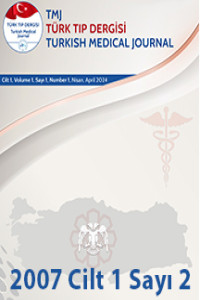Abstract
PERKÜTAN ENDOSKOPĐK GASTROSTOMĐNĐN MAJOR VE MİNOR KOMPLİKASYONLARI
Çeşitli nedenlerden dolayı yutma problemi olan hastalarda malnutrisyondan korunmada perkutan endoskopik gastrostomi (PEG) önemli rol oynamaktadır. Ancak PEG invaziv bir girişimdir ve bir çok PEG uygulamasına bağlı komplikasyon tarif edilmiştir. Bu çalışmanın amacı merkezimizde PEG bağlantılı komplikasyonları belirlemektir.
Bu çalışmada 1.Ocak.2004 ile 28.Şubat.2007 tarihleri arasında PEG uygulanan 18 hastada major komplikasyonlar minor komplikasyonlar, incelendi. PEG için tüm endikasyonlar nütrisyon ekibi tarafından belirlendi.
Minor komplikasyonlar; yara yeri enfeksiyonu iki hastada (%11.11), gastroparezi iki hastada (%11.11), tüpün yerinden çıkması bir hastada (%5.55) olmak üzere toplam 5 (%27.77) hastada izlendi.
Bir hastada (%5.55) tüpün yerinden çıkması sonrası gelişen peritonit ile bir hastada (%5.55) üst gastrointestinal kanama major komplikasyonlar idi.
Beş (%27.77) hastamızda minor ve 2 (%11.11) hastamızda major komplikasyonlar görülmüştür. Major komplikasyon oranımız literatüre göre yüksek olmakla birlikte, bir hastamızın tüpünü çekmesi
sonucu görülen peritonit bu oranı arttırmaktadır. Minor komplikasyon oranımız ise literatürle uyumludur. Hasta sayımızın az olması da sonucu etkilemektedir. Ancak buna rağmen PEG uygulamasının ciddi komplikasyonları olmadığı ve seçilmiş hastalarda kabul edilebilir en uygun modalite olduğu görüşündeyiz.
References
- 1. Del Rio P, Dell’Abate P, Soliani P, Arcuri MF, Ghirarduzzi A, Sianesi M. Complications of percutaneous endoscopic gastrostomy: a surgical experience. G Chir 2006; 27:388-91.
- 2. Pearce C B, Duncan H D. Enteral feeding. Nasogastric, nasojejunal, percutaneous endoscopic gastrostomy, or jejunostomy:its indications and limitations. Postgrad Med J 2002; 78:198-204.
- 3. Foster J M, Filocamo P, Nava H, Schiff M, Hicks W, Rigual N, Smith J, Loree T, Gibbs JF. The introducer technique is the optimal method for placing percutaneous endoscopic gastrostomy tubes in head and neck cancer patients. Surg Endosc 2007; 21:897-901.
- 4. Anis M K, Abid S, Jafri W, Abbas Z, Shah AH, Hamid S, Wasaya H. Acceptability and outcomes of the Percutaneous Endoscopic Gastrostomy (PEG) tube placement patients and care givers perspectives. BMC Gastroenterol 2006; 6:37.
- 5. Dinkel H P, Beer K T, Zbären P, Triller J. Establishing radiological percutaneous gastrostomy with balloon-retained tubes as an alternative to endoscopic and sırgical gastrostomy in patients with tumours of the head and neck or oesophagus. B J Radiol 2002;75:371-7.
- 6. Varnier A, Iona L, Dominutti E, Deotto E, Bianchi A, Iengo A, Zacquini S, Benedetto D P. Percutaneous endoscopic gastrostomy: complications in the short and long-term follow-up and efficacy on nutritional status. Eur Med Phys 2006;42:23-6.
- 7. Chong V H, Vu C. Percutaneous endoscopic gastrostomy outcomes: can patient profiles predict mortality and weaning? Singapore Med J 2006;47:383-7.
- 8. Simon JE, Price CSG, Khan S. Percutaneous endoscopic gastrostomy: 30-day mortality trends and risk factors. J Postgrad Med 2005;51:23-29
Abstract
Percutaneous endoscopic gastrostomy (PEG) plays an important role in avoiding malnutrition in patients with swallowing disorders from various etiology. However PEG is an invasive procedure and
many PEG-related complications have been described. The aim of this study is to determine the PEG-related complications in our centre.
We have analysed in this study the incidence of major complications and minor complications, in 18 patients who required PEG from January 1, 2004 to February 28, 2007. All indications for PEG
were deemed appropriate by the nutrition team.
Minor complications have been occured in 5 (27.77%) patients; wound infection in two (11.11%) patients, gastroparesis in two (11.11%) patients, dislodgement of tube in one (5.55%) patient. One
patient (5.55%) showed peritonitis after dislodgement of the tube and one patient (5.55%) upper gastrointestinal bleeding as major complications.
We had 5 (27.77%) minor and 2 (11.11%) major complications in our patients. In this study, major complication rate is seen higher than in the literature. But one of them is peritonitis after patient’s self dislodgement of the PEG-tube by the patient and increased complication rate. Minor complications rate is comparable to the literature. Also the small sample size in our study may affect the results. We suggest that PEG-tube placement is relatively free from serious complications and an acceptable and appropriate modality for the nutrition
of selected patients.
References
- 1. Del Rio P, Dell’Abate P, Soliani P, Arcuri MF, Ghirarduzzi A, Sianesi M. Complications of percutaneous endoscopic gastrostomy: a surgical experience. G Chir 2006; 27:388-91.
- 2. Pearce C B, Duncan H D. Enteral feeding. Nasogastric, nasojejunal, percutaneous endoscopic gastrostomy, or jejunostomy:its indications and limitations. Postgrad Med J 2002; 78:198-204.
- 3. Foster J M, Filocamo P, Nava H, Schiff M, Hicks W, Rigual N, Smith J, Loree T, Gibbs JF. The introducer technique is the optimal method for placing percutaneous endoscopic gastrostomy tubes in head and neck cancer patients. Surg Endosc 2007; 21:897-901.
- 4. Anis M K, Abid S, Jafri W, Abbas Z, Shah AH, Hamid S, Wasaya H. Acceptability and outcomes of the Percutaneous Endoscopic Gastrostomy (PEG) tube placement patients and care givers perspectives. BMC Gastroenterol 2006; 6:37.
- 5. Dinkel H P, Beer K T, Zbären P, Triller J. Establishing radiological percutaneous gastrostomy with balloon-retained tubes as an alternative to endoscopic and sırgical gastrostomy in patients with tumours of the head and neck or oesophagus. B J Radiol 2002;75:371-7.
- 6. Varnier A, Iona L, Dominutti E, Deotto E, Bianchi A, Iengo A, Zacquini S, Benedetto D P. Percutaneous endoscopic gastrostomy: complications in the short and long-term follow-up and efficacy on nutritional status. Eur Med Phys 2006;42:23-6.
- 7. Chong V H, Vu C. Percutaneous endoscopic gastrostomy outcomes: can patient profiles predict mortality and weaning? Singapore Med J 2006;47:383-7.
- 8. Simon JE, Price CSG, Khan S. Percutaneous endoscopic gastrostomy: 30-day mortality trends and risk factors. J Postgrad Med 2005;51:23-29
Details
| Primary Language | English |
|---|---|
| Subjects | General Surgery, Gastroenterology and Hepatology |
| Journal Section | Research Article |
| Authors | |
| Publication Date | July 15, 2007 |
| Published in Issue | Year 2007 Volume: 1 Issue: 2 |


